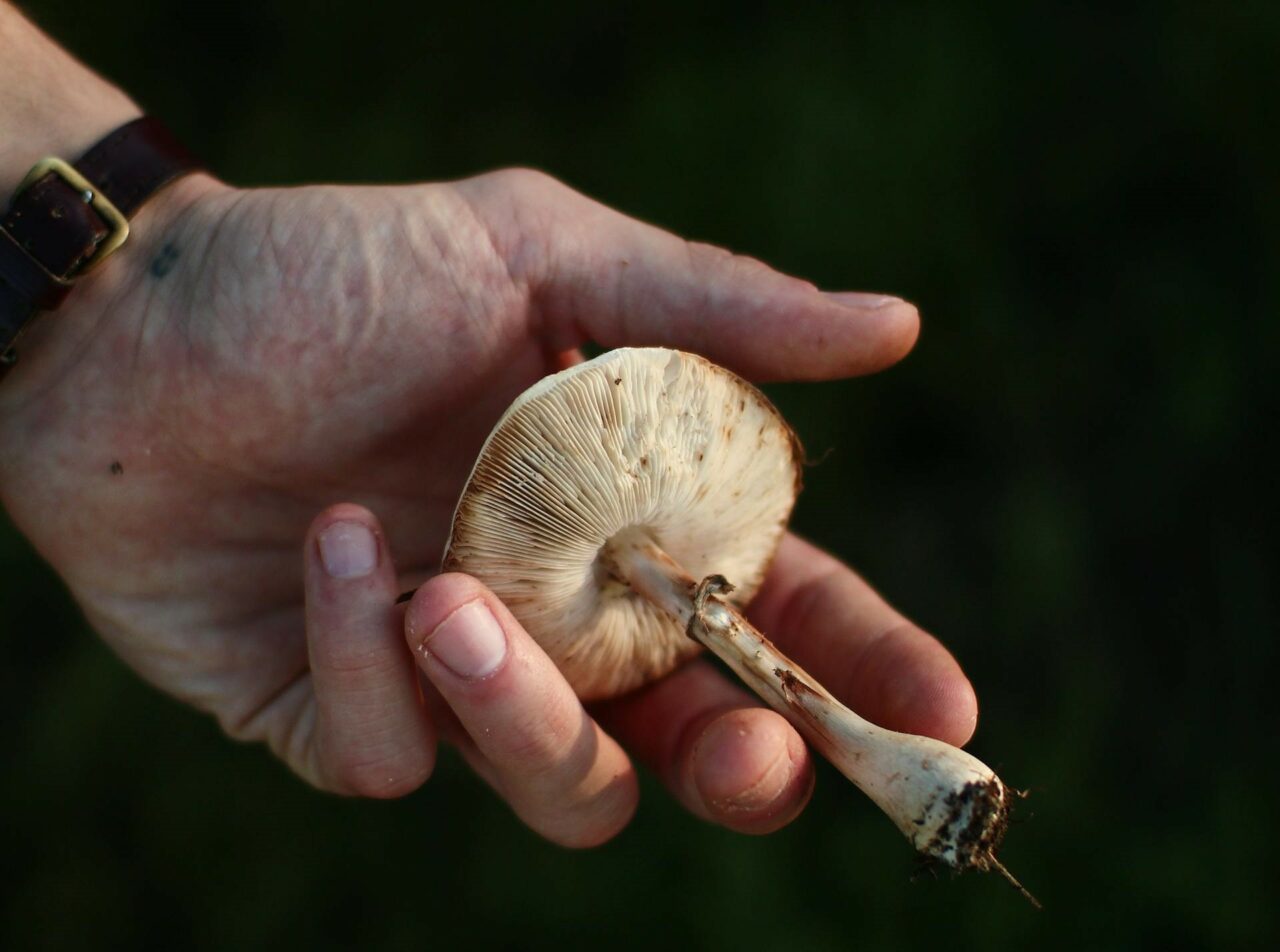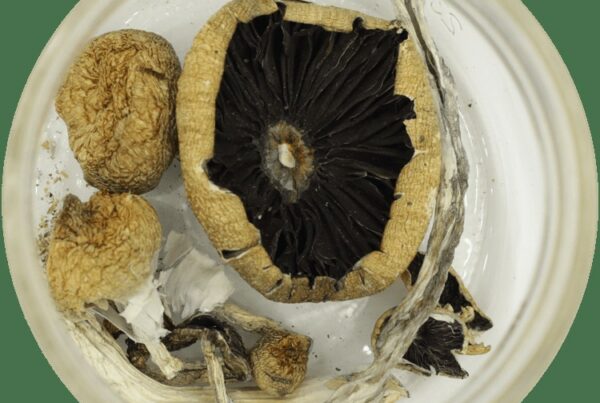Psilocybin mushrooms, a traditional psychedelic similar to LSD in terms of their effect on the serotonin 5-HT2A receptor, are currently under investigation for their potential role in therapy for mental health disorders. This includes major depression, anxiety, emotional distress, cluster headaches, and migraines.
In order to understand how shrooms can be beneficial for these conditions, one must delve into how these substances are metabolized in the body. By understanding this, researchers and users can gain insights into how the active compounds produce their psychological and therapeutic effects. This article offers a basic overview of the pharmacology and pharmacokinetics of psilocybin.
[toc]
Key Highlights:
- Half of the ingested psychedelic fungi is absorbed and disseminated throughout the body.
- The compound in the fungi undergoes a process of dephosphorylation, largely in the liver, by the enzyme alkaline phosphatase.
- Only 3.4% of the compound is expelled in its unaltered form within a 24-hour period, with the majority being eliminated as a stable metabolite.
What is Pharmacokinetics?
Pharmacokinetics (PK) refers to the study of how substances, like drugs, are processed by the body once they are introduced into the system. While related to pharmacodynamics, which studies how a compound interacts with the body, PK specifically focuses on four main aspects: absorption, distribution, metabolism, and excretion (ADME).
A thorough comprehension of these processes allows healthcare providers to prescribe the most effective medications while minimizing risk. It also supports them in customizing treatments to suit each patient’s unique physiological make-up and lifestyle.
How does Pharmacokinetics Relate to Psilocybin?
There’s been a growing interest in psilocybin and psilocin, the primary active compounds found in certain types of magic mushrooms, among both researchers and users. Pharmacokinetics provides insight into how the body interacts with mushrooms containing psilocybin, shedding light on their potential effects, be it medicinal or recreational.
These compounds, sometimes referred to as “magic,” “psychedelic,” “medicinal,” or “sacred,” are found in fungi that are consumed. The The potency of psilocybin mushrooms can differ greatly based on a variety of factors. These include the specific mushroom species, their place of origin, size, the conditions they grow and dry in, and their age. All these factors can significantly affect the concentration of the active compounds in the mushrooms.
Although these mushrooms are naturally occurring in the wild, scientific advancements have made it possible to synthesize them in laboratories. Both the naturally occurring and synthesized mushrooms exhibit low toxicity, but they may cause mild side effects like nausea or vomiting.
Despite these minor physical side effects, the compounds present in these mushrooms have demonstrated potential therapeutic benefits because of their safety profile and non-addictive properties. These advantages have piqued the interest of researchers, leading them to investigate their application in psychotherapy, specifically for treating anxiety and depression.
Understanding the 4 Stages of Pharmacokinetics
Psilocybin, the primary compound found in these mushrooms, is inactive in its natural state. It acts as a prodrug, converting into its active form, psilocin, with the help of enzymes like alkaline phosphatase. This conversion allows psilocin to be absorbed and circulated throughout the body, reaching different tissues. However, post oral ingestion, psilocybin cannot be detected in the circulatory system, feces, or urine.
The Absorption Process
The absorption process refers to how the compound enters the bloodstream from the point of administration. This process determines the speed and effectiveness of the compound reaching its target, such as the plasma. The most common route of administration is oral, although inhalation has also been tried but found to be less effective.
The process of absorption also involves the release of the compound from the dosage form during oral ingestion. Factors like delays in the throat or esophagus can impact this, possibly slowing down the effects or causing discomfort. Once the compound reaches the stomach, the acidic environment there can start breaking it down before it enters the bloodstream.
Studies conducted on animals suggest that only about 50% of orally administered psychedelics are absorbed and distributed throughout the body.
Factors that Influence the Absorption Process
Various factors can impact the absorption process, leading to variations in the onset, intensity, and duration of the effects:
- Contents of the Stomach: When the stomach is full, it can delay the absorption process as it slows down the onset of the effects. Conversely, a faster absorption is possible when the stomach is empty.
- Phase I (CYP450 Reactions): In this phase, hallucinogenic drugs are oxidized into polar metabolites.
- Phase II (UGT Reactions): During this phase, the metabolites are conjugated to aid their distribution.
- These phases neutralize the drug and prepare it for elimination through urine or bile.
- 4-hydroxyindole-3-acetaldehyde
- 4-hydroxytryptophol
- 4-hydroxyindole-3-acetic acid (4-HIAA)
- Body Fat: Substances can potentially accumulate in fat tissues, which might prolong their effects.
- Age: Metabolic rates and body composition usually vary with age.
- Zero-Order Kinetics: The substance is removed at a steady rate, regardless of its concentration.
- First-Order Kinetics: The elimination rate is proportional to the concentration of the drug.
Psilocybin’s phosphate group exhibits a high level of polarity. This, paired with the positive charge of the amine group, gives the molecule a zwitterionic nature, amplifying its solubility in water compared to psilocin. Without the phosphate group, psilocin becomes more soluble in lipids, metabolically accessible, and more seamlessly absorbed into the intestines.
The Metabolic Process
Metabolism refers to how the body transforms mushroom strains into components that can be easily eliminated. This process involves enhancing the water solubility of the mushroom for effective renal clearance and is crucial for activating its effects.
This metabolism primarily occurs in the liver and can be divided into two stages:
Once the compound is absorbed, it undergoes a metabolic conversion in the liver. The primary metabolic process is dephosphorylation, where psilocybin changes into psilocin due to the enzyme alkaline phosphatase. This transformation predominantly happens in the liver. Additionally, secondary metabolic processes can create various byproducts.
Psilocin then goes through extensive Phase I metabolism in the liver, forming different metabolites:
The Phase II metabolism is catalyzed by the UDP-glucuronosyltransferase enzyme family, with UGT1A10 being the principal pathway. Psilocin-O-glucuronide is the primary metabolite found in urine, with 2% to 4% of psilocin being expelled unchanged.
Dissemination
Dissemination denotes the movement of psilocin throughout the body once it has entered the bloodstream. As a lipophilic compound, psilocin can traverse the blood-brain barrier and access the central nervous system.
system.Various factors including the product’s size, polarity, and protein-binding capacity, as well as an individual’s physiological characteristics such as hydration status and body composition, significantly influence this procedure.
The goal is to achieve an effective concentration at the intended site. This requires the product to reach its specific location—defined by the volume of distribution—while remaining unattached to proteins, thus enabling active interaction with its receptor.
What Factors Impact the Dissemination Processes?
Several factors can affect the dissemination process:
Effects typically begin to manifest within 20-40 minutes following consumption, peaking around 80-100 minutes. The effects of magic mushrooms generally persist for about 4-6 hours.
How is Dissemination to the Brain Achieved?
An initial experimental study conducted on two species demonstrated that the order of its binding affinity is 5HT2A > 5HT1A > 5HT2B [23]. It also attaches to receptors of dopamine D1, 5HT1E, 5HT5A, 5HT7, 5HT6, D3, 5HT2C, and 5HT1B.
It acts as a partial agonist at the 5HT2A receptor, with around 40% efficacy. The psychedelic effects are attributed to its partial agonist activity at 5HT1A autoreceptors.
The mood-elevating and psychotomimetic experiences may stem from the perceived correlation between increased dopamine levels and sensations of depersonalization and euphoria. Hallucinogens work by changing neurochemistry and receptor activity. It enhances 5HT2A agonist activity by stimulating BDNF synthesis in the hippocampus, which in turn promotes neurogenesis and reduces conditioned fear-related behaviours.
Elimination
Elimination refers to the process where the The body expels substances largely through the kidneys, but also via other organs such as the lungs, skin, and gastrointestinal tract. Specifically, in the kidneys, a naturally occurring psychedelic drug is either filtered in the glomerulus or secreted in the tubules, adding some intricacy to the process due to reabsorption.
The primary compound has a half-life of about 160 minutes, while psilocin’s half-life is around 50 minutes. Animal studies indicate that this is primarily expelled in urine, accounting for roughly 65% within 8 hours post-consumption. Small amounts of this substance can still be detected in bile and feces.
In the human body, approximately 3.4% of the psychedelic compound is discharged in its original form within 24 hours, while the majority is expelled as psilocin-O-glucuronide, a more stable metabolite. This stability allows for the compound to be identified in urine samples over a longer duration.
There are two primary modes of substance elimination:
Most psychedelic substances follow the first-order kinetics method, reaching steady-state concentrations after four to five half-lives. Complete elimination also occurs after four to five half-lives.
Discover Our Range of Psychedelic Mushrooms
The metabolic process can vary among different fungi. By choosing trusted online suppliers like Magic Mushroom Toronto Canada, you can steer clear of accidentally ingesting poisonous mushrooms. Certain types, such as Agaric mushrooms, can induce potent and undesirable effects. Hence, it’s vital to acquire magic mushrooms from reliable sources, rather than untrustworthy street vendors or unguided foraging.
| Feature | Enigma | Full Moon Party | Gold Member |
| Strain Type | Psilocybe Cubensis OMNI | Psilocybe cubensis (Thai Koh Samui) | Psilocybe cubensis |
| Potency | Exceptionally high; 3.8% tryptamine content | Moderate to high potency | High potency |
| Visual Characteristics | Resembles a blob or resembles a cauliflower or brain | Has the typical look of a cubensis, moderately sized | Thick white stems with golden caramel caps and visible blue bruising |
| Effects | Considered the most potent, yielding intense effects | Potent mental high, delayed onset followed by vivid visuals | Offers powerful visuals and feelings of euphoria |
Discover Psilocybin Mushroom Usage Online
It’s essential for medical professionals, researchers, and users to comprehend the pharmacokinetics of shrooms. This understanding enables you to make informed decisions about dosage and timing, hence minimizing potential risks.
Find the perfect psychedelic experience on Magic Mushroom Toronto Canada. Whether you’re looking for a soothing journey or deep exploration, our vast product selection is tailored to meet your unique requirements. Enjoy premium, safe, and quality-assured shrooms, free from the worry of unknown sources or harmful mushrooms.
Experience the finest magic mushrooms Canada has to offer and elevate your psychedelic journey to new heights.
Frequently Asked Questions
Are there any documented interactions between shrooms and other medications?
Our products may interact with certain medications, particularly those that affect serotonin levels, such as SSRIs (Selective Serotonin Reuptake Inhibitors). SSRIs and SNRIs (Serotonin and Norepinephrine Reuptake Inhibitors) tend to lessen the effects, unlike non-serotonergic antidepressants. This reduced effect could last for up to three months after stopping the use of the antidepressant.
Do all psychedelics follow the same pathway as psilocybin?
No, each psychedelic substance has a unique structure that requires different metabolic processes to become active, and they bind to various receptors in the body. The administration method also affects how each psychedelic is absorbed. While the basic principles of absorption, metabolism, and distribution stay the same, the specific pathways and effects vary for each substance.
Can the form of the shroom affect the pharmacokinetics?
Yes, the form (whether fresh, powdered, or dried mushrooms) can affect the absorption rate. For example, powdered forms might be absorbed faster than whole dried ones due to quicker dissolution.
Related Reads:





